Peridynamic Analysis of Marine Composites under Shock Loads by Considering Thermomechanical Coupling Effects
Abstract
:1. Introduction
2. Peridynamic (PD) Theory
2.1. Basic Concepts in PD Theory
2.2. PD Mechanical Laminate Model
2.3. PD Thermal Laminate Model
2.4. Failure Criteria
3. Numerical Implementation
3.1. Problem Description
3.2. Numerical Results
3.2.1. Subjected to Uniform Pressure Loading
3.2.2. Subjected to Uniform Non-Uniform Pressure Load
4. Conclusions
Acknowledgments
Author Contributions
Conflicts of Interest
References
- Mouritz, A.P. The damage to stitched GRP laminates by underwater explosion shock loading. Compos. Sci. Technol. 1995, 55, 365–374. [Google Scholar] [CrossRef]
- Hellbratt, S.-E. Experiences from Design and Production of the 72 m CFRP-Sandwich Corvette Visby. In Proceedings of the 6th International Conference on Sandwich Construction; CRC Press: Fort Lauderdale, FL, USA, 2003; pp. 15–24. [Google Scholar]
- Li, H.C.H.; Herszberg, I.; Davis, C.E.; Mouritz, A.P.; Galea, S.C. Health monitoring of marine composite structural joints using fibre optic sensors. Compos. Struct. 2006, 75, 321–327. [Google Scholar] [CrossRef]
- Baley, C.; Davies, P.; Grohens, Y.; Dolto, G. Application of interlaminar tests to marine composites. A literature review. Appl. Compos. Mater. 2004, 11, 99–126. [Google Scholar] [CrossRef]
- Ghobadi, A. Common type of damages in composites and their inspections. World J. Mech. 2017, 7, 24–33. [Google Scholar] [CrossRef]
- Richardson, M.O.W.; Wisheart, M.J. Review of low-velocity impact properties of composite materials. Compos. Part A Appl. Sci. Manuf. 1996, 27, 1123–1131. [Google Scholar] [CrossRef]
- Diyaroglu, C. Peridynamics and Its Applications in Marine Structures. Ph.D. Thesis, University of Strathclyde, Glasgow, UK, 2016. [Google Scholar]
- LeBlanc, J.; Shukla, A. Dynamic response of curved composite panels to underwater explosive loading: Experimental and computational comparisons. Compos. Struct. 2011, 93, 3072–3081. [Google Scholar] [CrossRef]
- Tagarielli, V.L.; Schiffer, A. The response to underwater blast. In Dynamic Deformation, Damage and Fracture in Composite Materials and Structures; Woodhead Publishing: Sawston, UK, 2016; pp. 279–307. [Google Scholar]
- Arora, H.; Rolfe, E.; Kelly, M.; Dear, J.P. Chapter 7—Full-scale air and underwater-blast loading of composite sandwich panels. In Explosion Blast Response of Composites; Woodhead Publishing: Sawston, UK, 2017; pp. 161–199. [Google Scholar]
- Hall, D.J. Examination of the effects of underwater blasts on sandwich composite structures. Compos. Struct. 1989, 11, 101–120. [Google Scholar] [CrossRef]
- Latourte, F.; Gregoire, D.; Zenkert, D.; Wei, X.D.; Espinosa, H.D. Failure mechanisms in composite panels subjected to underwater impulsive loads. J. Mech. Phys. Solids 2011, 59, 1623–1646. [Google Scholar] [CrossRef]
- LeBlanc, J.; Shukla, A. Dynamic response and damage evolution in composite materials subjected to underwater explosive loading: An experimental and computational study. Compos. Struct. 2010, 92, 2421–2430. [Google Scholar] [CrossRef]
- Wadley, H.; Dharmasena, K.; Chen, Y.C.; Dudt, P.; Knight, D.; Charette, R.; Kiddy, K. Compressive response of multilayered pyramidal lattices during underwater shock loading. Int. J. Impact Eng. 2008, 35, 1102–1114. [Google Scholar] [CrossRef]
- Rabczuk, T.; Samaniego, E.; Belytschko, T. Simplified model for predicting impulsive loads on submerged structures to account for fluid-structure interaction. Int. J. Impact Eng. 2007, 34, 163–177. [Google Scholar] [CrossRef]
- Hoo Fatt, M.S.; Palla, L. Analytical modeling of composite sandwich panels under blast loads. J. Sandw. Struct. Mater. 2009, 11, 357–380. [Google Scholar] [CrossRef]
- Kazancı, Z. A review on the response of blast loaded laminated composite plates. Prog. Aerosp. Sci. 2016, 81, 49–59. [Google Scholar] [CrossRef]
- Carrera, E.; Demasi, L.; Manganello, M. Assessment of plate elements on bending and vibrations of composite structures. Mech. Adv. Mater. Struct. 2002, 9, 333–357. [Google Scholar] [CrossRef]
- Liew, K.M.; Zhao, X.; Ferreira, A.J.M. A review of meshless methods for laminated and functionally graded plates and shells. Compos. Struct. 2011, 93, 2031–2041. [Google Scholar] [CrossRef]
- Dawe, D.J. Use of the finite strip method in predicting the behaviour of composite laminated structures. Compos. Struct. 2002, 57, 11–36. [Google Scholar] [CrossRef]
- Madenci, E.; Oterkus, E. Peridynamic Theory and Its Applications; Springer: Berlin, Germany, 2014. [Google Scholar]
- Hillerborg, A.; Modéer, M.; Petersson, P.E. Analysis of crack formation and crack growth in concrete by means of fracture mechanics and finite elements. Cem. Concr. Res. 1976, 6, 773–781. [Google Scholar] [CrossRef]
- Belytschko, T.; Black, T. Elastic crack growth in finite elements with minimal remeshing. Int. J. Numer. Methods Eng. 1999, 45, 601–620. [Google Scholar] [CrossRef]
- Silling, S.A.; Epton, M.; Weckner, O.; Xu, J.; Askari, E. Peridynamic states and constitutive modeling. J. Elast. 2007, 88, 151–184. [Google Scholar] [CrossRef]
- Oterkus, E.; Madenci, E. Peridynamic analysis of fiber-reinforced composite materials. J. Mech. Mater. Struct. 2012, 7, 45–84. [Google Scholar] [CrossRef]
- Kilic, B.; Agwai, A.; Madenci, E. Peridynamic theory for progressive damage prediction in center-cracked composite laminates. Compos. Struct. 2009, 90, 141–151. [Google Scholar] [CrossRef]
- Oterkus, E. Peridynamic Theory for Modeling Three-Dimensional Damage Growth in Metallic and Composite Structures. Ph.D. Thesis, University of Arizona, Tucson, AZ, USA, 2010. [Google Scholar]
- Oterkus, E.; Madenci, E. Peridynamic theory for damage initiation and growth in composite laminate. Key Eng. Mater. 2011, 488–489, 355–358. [Google Scholar] [CrossRef]
- Hu, Y.L.; Madenci, E. Bond-based peridynamic modeling of composite laminates with arbitrary fiber orientation and stacking sequence. Compos. Struct. 2016, 153, 139–175. [Google Scholar] [CrossRef]
- Biot, M.A. Thermoelasticity and irreversible thermodynamics. J. Appl. Phys. 1956, 27, 240–253. [Google Scholar] [CrossRef]
- Oterkus, S.; Madenci, E.; Agwai, A. Peridynamic thermal diffusion. J. Comput. Phys. 2014, 265, 71–96. [Google Scholar] [CrossRef] [Green Version]
- Oterkus, S.; Madenci, E.; Agwai, A. Fully coupled peridynamic thermomechanics. J. Mech. Phys. Solids 2014, 64, 1–23. [Google Scholar] [CrossRef] [Green Version]
- Oterkus, S.; Madenci, E. Fully Coupled Thermomechanical Analysis of Fiber Reinforced Composites Using Peridynamics. In Proceedings of the 55th AIAA/ASME/ASCE/AHS/SC Structures, Structural Dynamics, and Materials Conference—SciTech Forum and Exposition, National Harbor, MD, USA, 13–17 January 2014. [Google Scholar]
- Silling, S.A.; Askari, E. A meshfree method based on the peridynamic model of solid mechanics. Comput. Struct. 2005, 83, 1526–1535. [Google Scholar] [CrossRef]
- Oterkus, S. Peridynamics for the Solution of Multiphysics Problems. Ph.D. Thesis, University of Arizona, Tucson, AZ, USA, 2015. [Google Scholar]
- Silling, S.; Weckner, O.; Askari, E.; Bobaru, F. Crack nucleation in a peridynamic solid. Int. J. Fract. 2010, 162, 219–227. [Google Scholar] [CrossRef]
- Diyaroglu, C.; Oterkus, E.; Madenci, E.; Rabczuk, T.; Siddiq, A. Peridynamic modeling of composite laminates under explosive loading. Compos. Struct. 2016, 144, 14–23. [Google Scholar] [CrossRef] [Green Version]
- Cimpoeru, S.J.; Ritzel, D.V.; Brett, J.M. Chapter 1—Physics of explosive loading of structures. In Explosion Blast Response of Composites; Woodhead Publishing: Sawston, UK, 2017; pp. 1–22. [Google Scholar]
- Turkmen, H.S.; Mecitoglu, Z. Nonlinear structural response of laminated composite plates subjected to blast loading. AIAA J. 1999, 37, 1639–1647. [Google Scholar] [CrossRef]
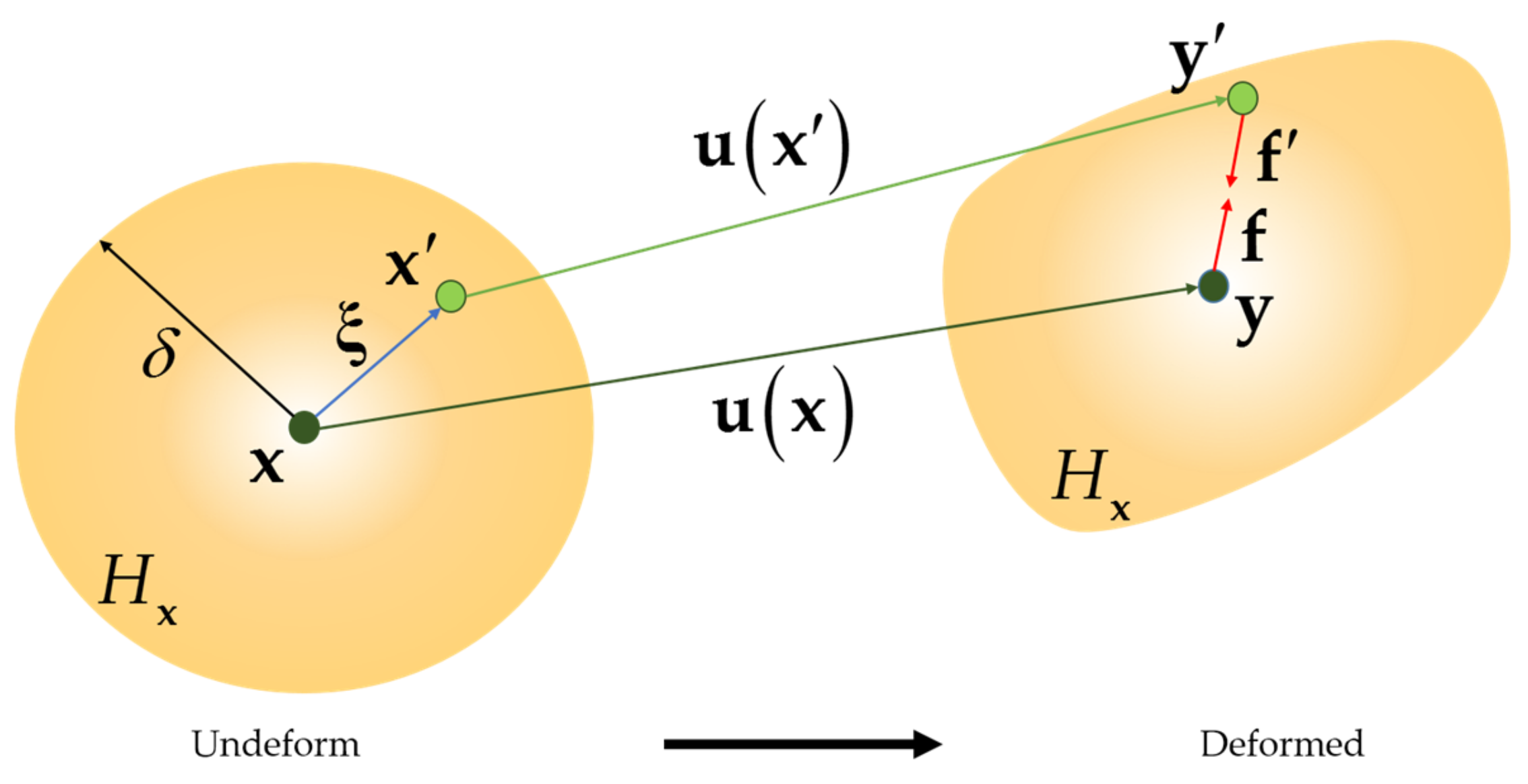
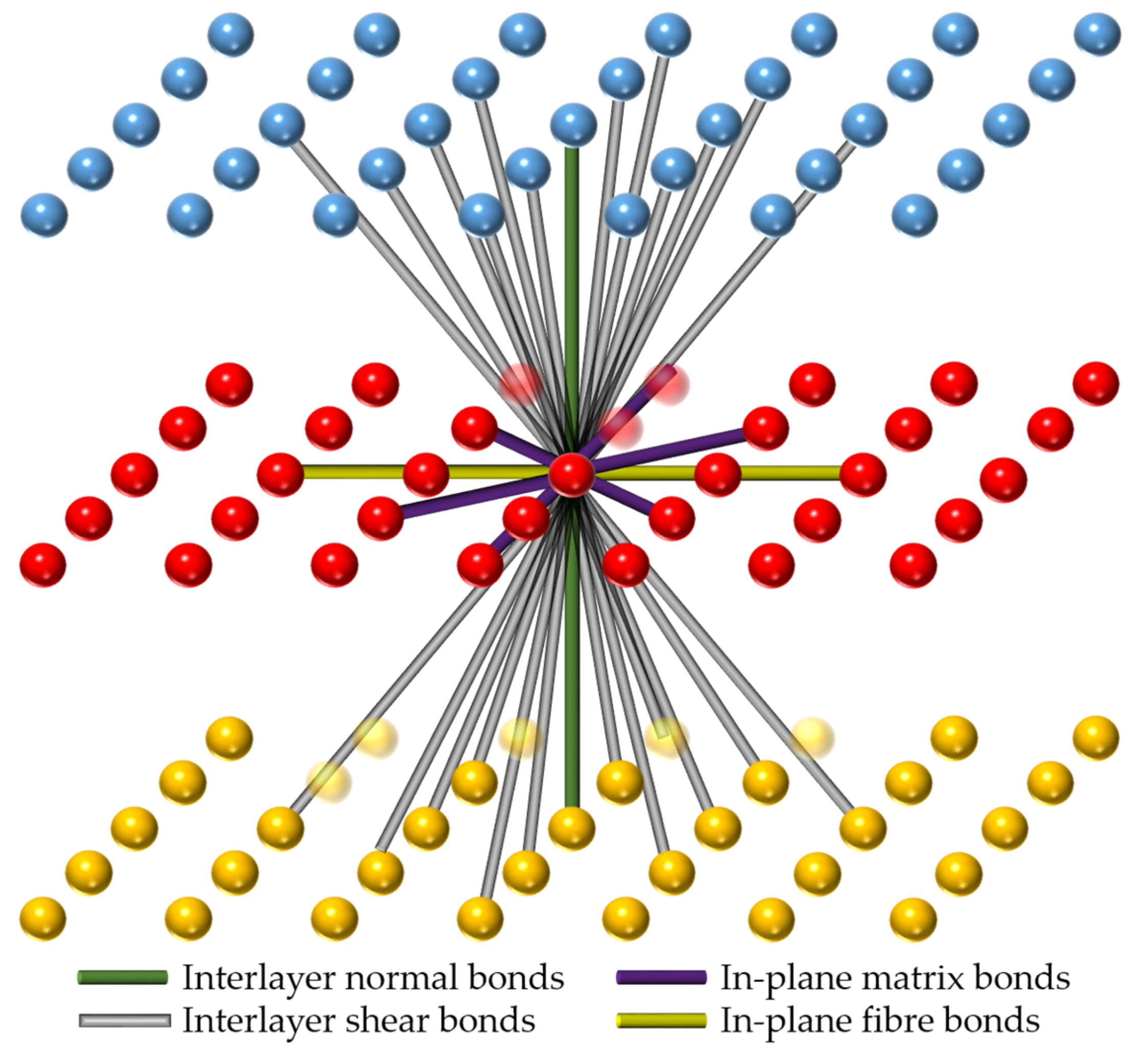
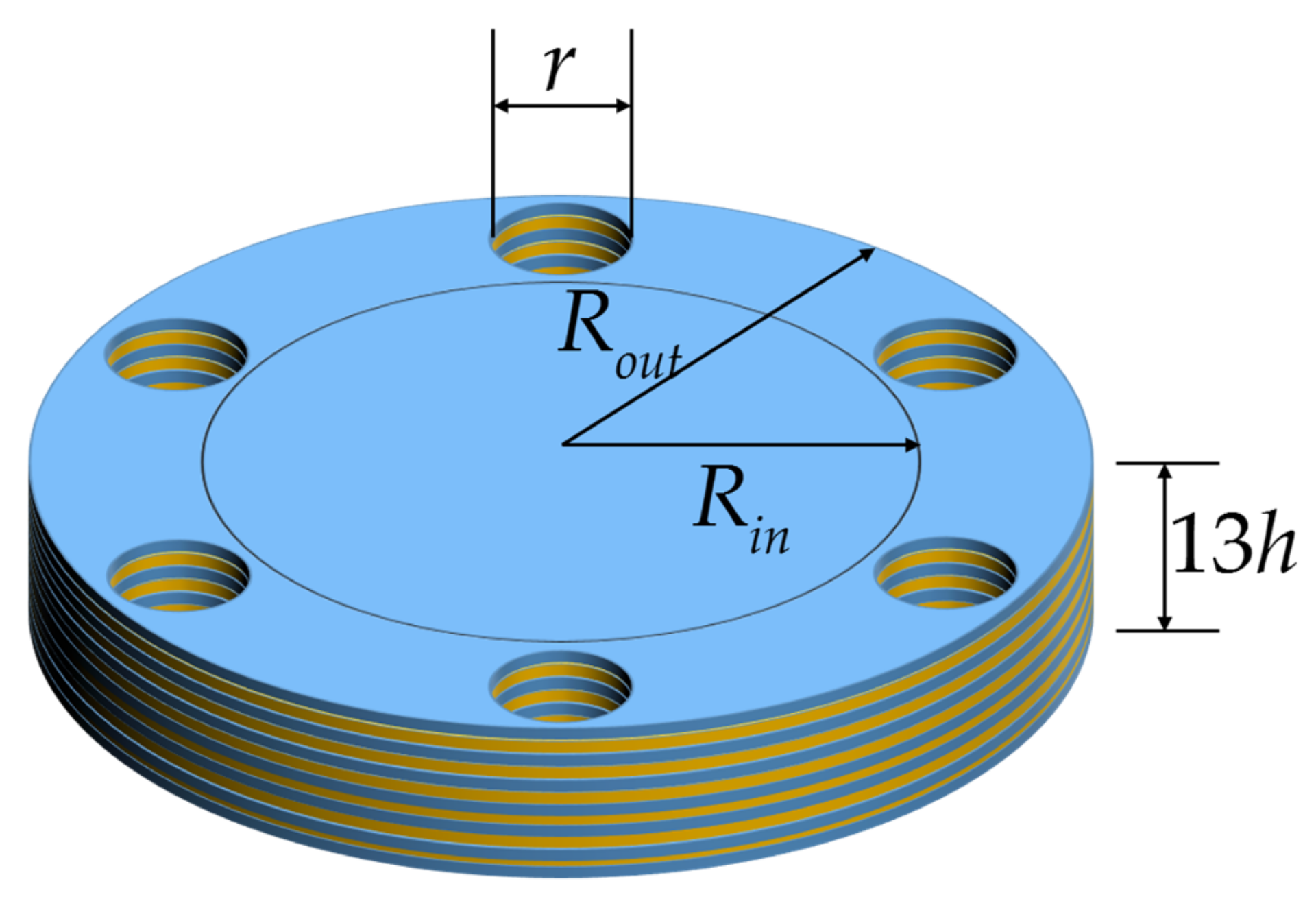

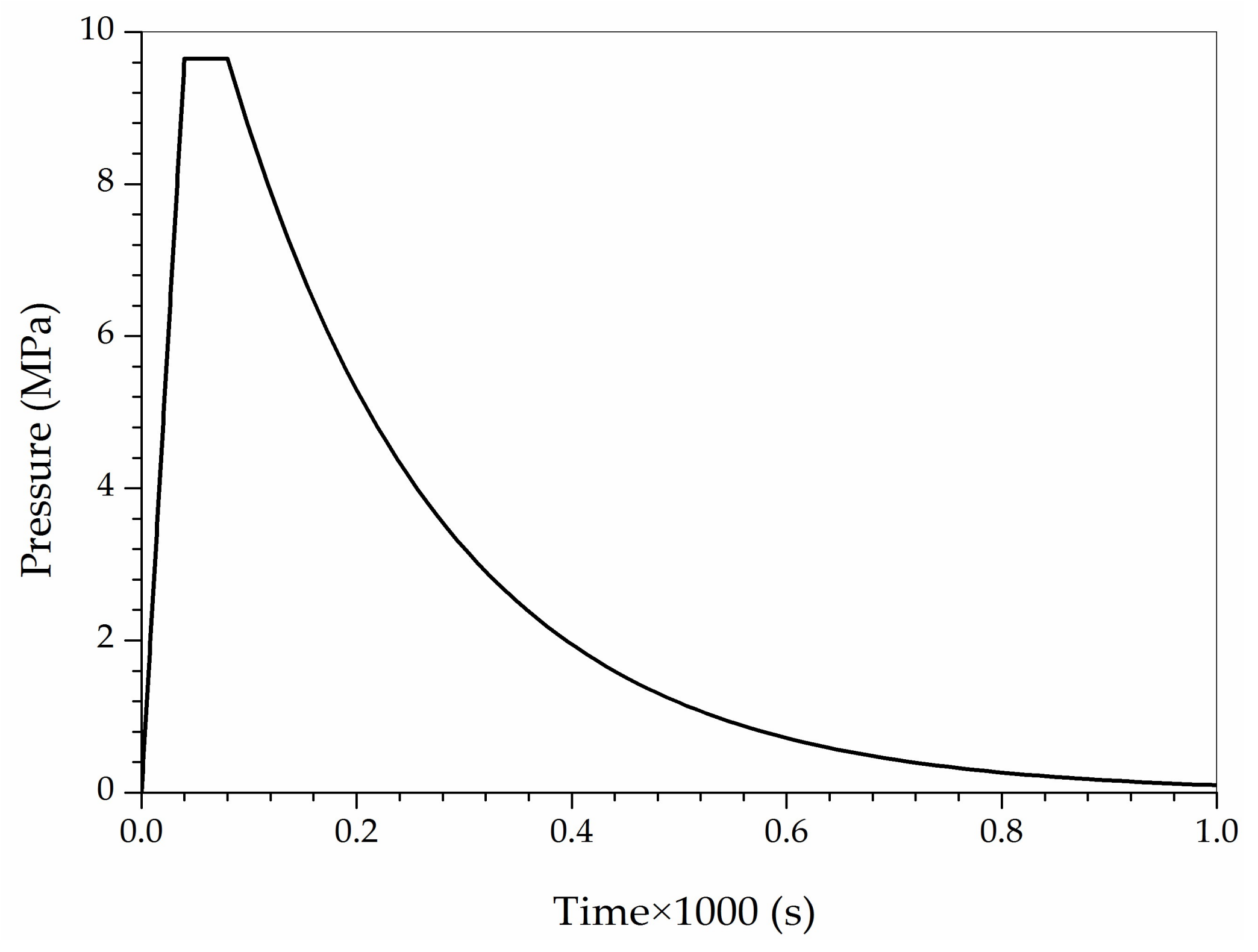
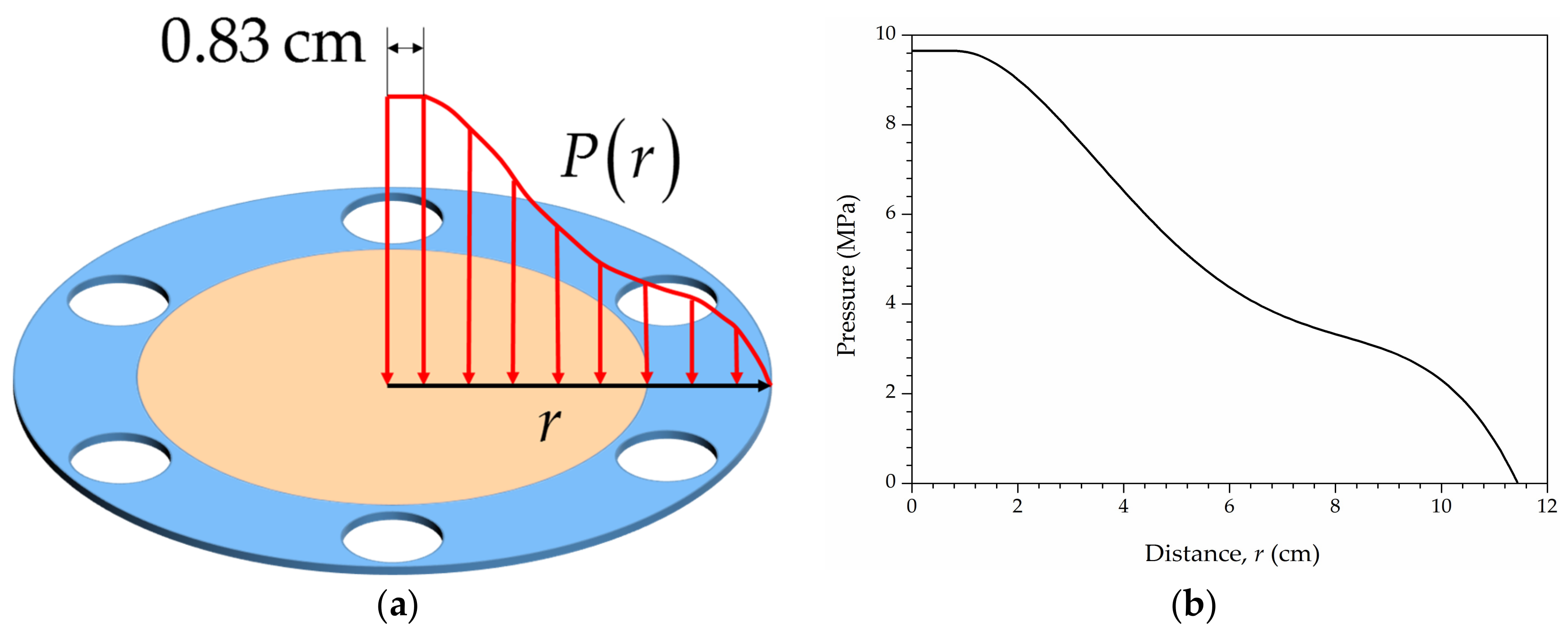
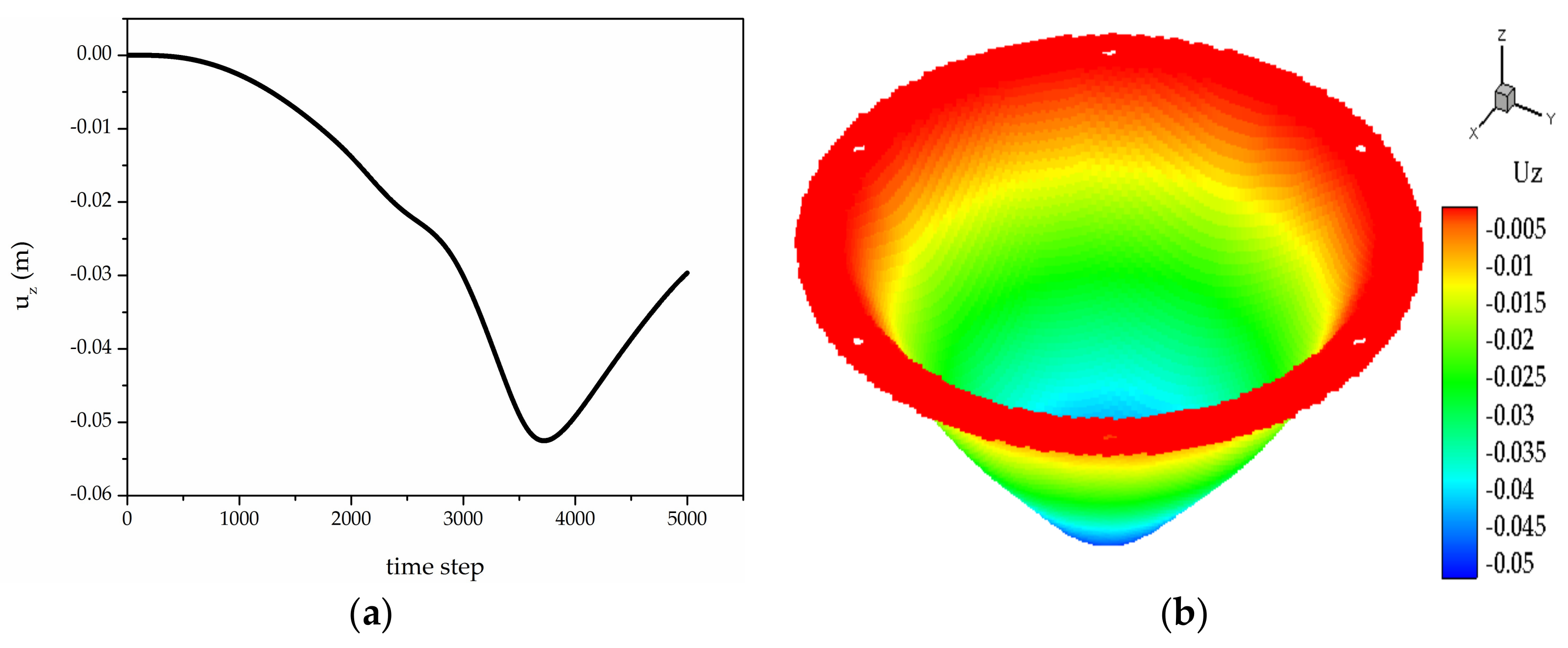
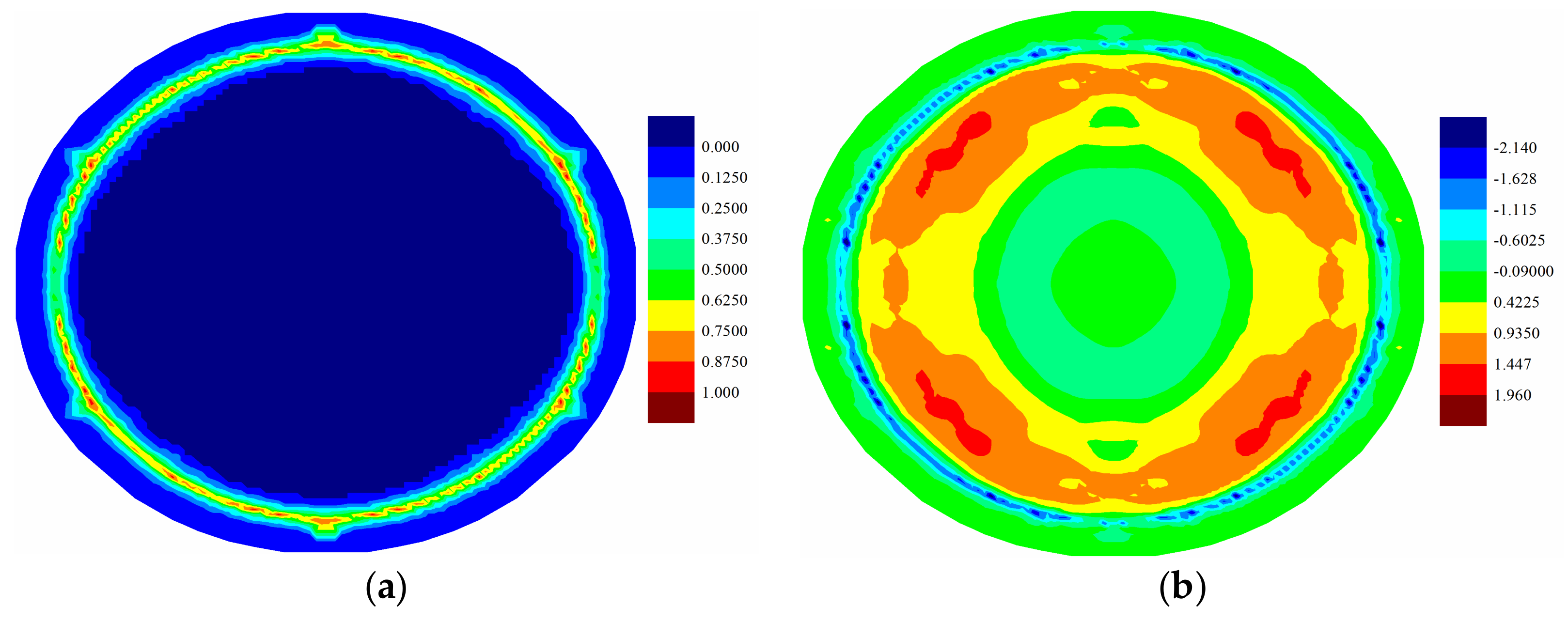

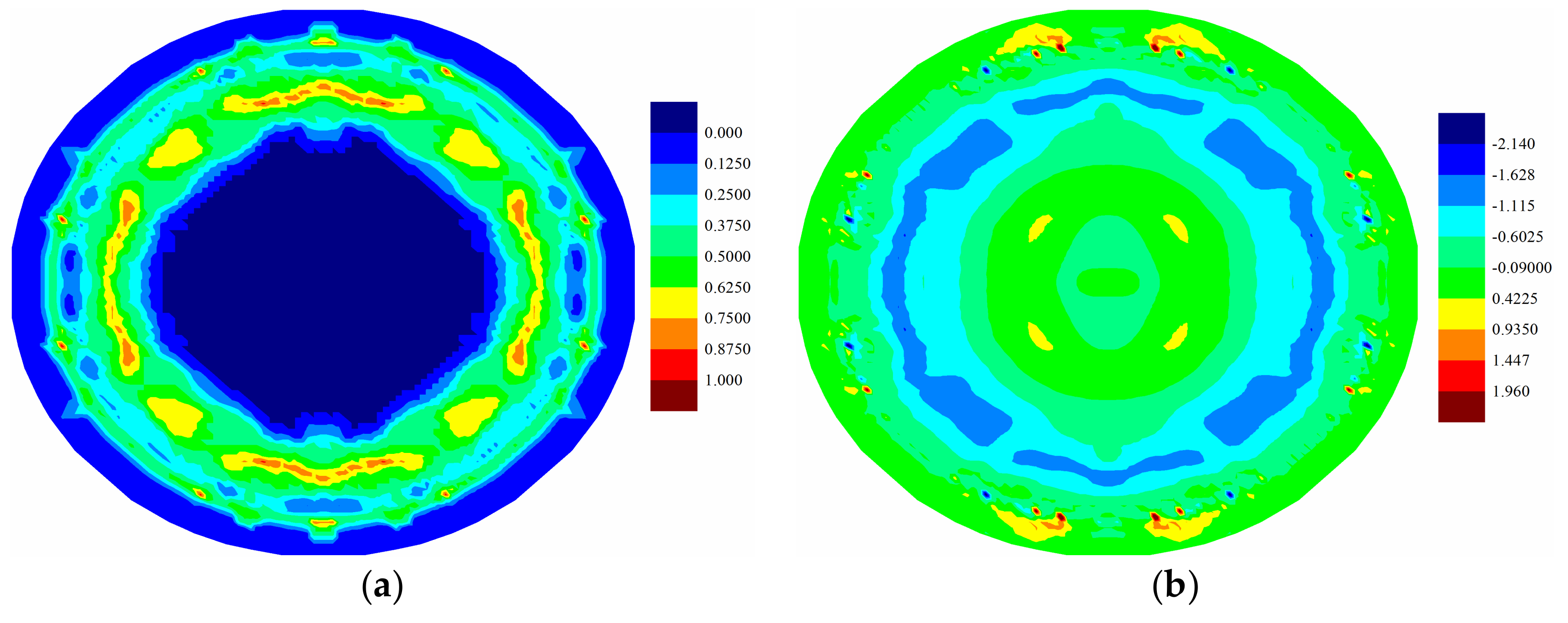

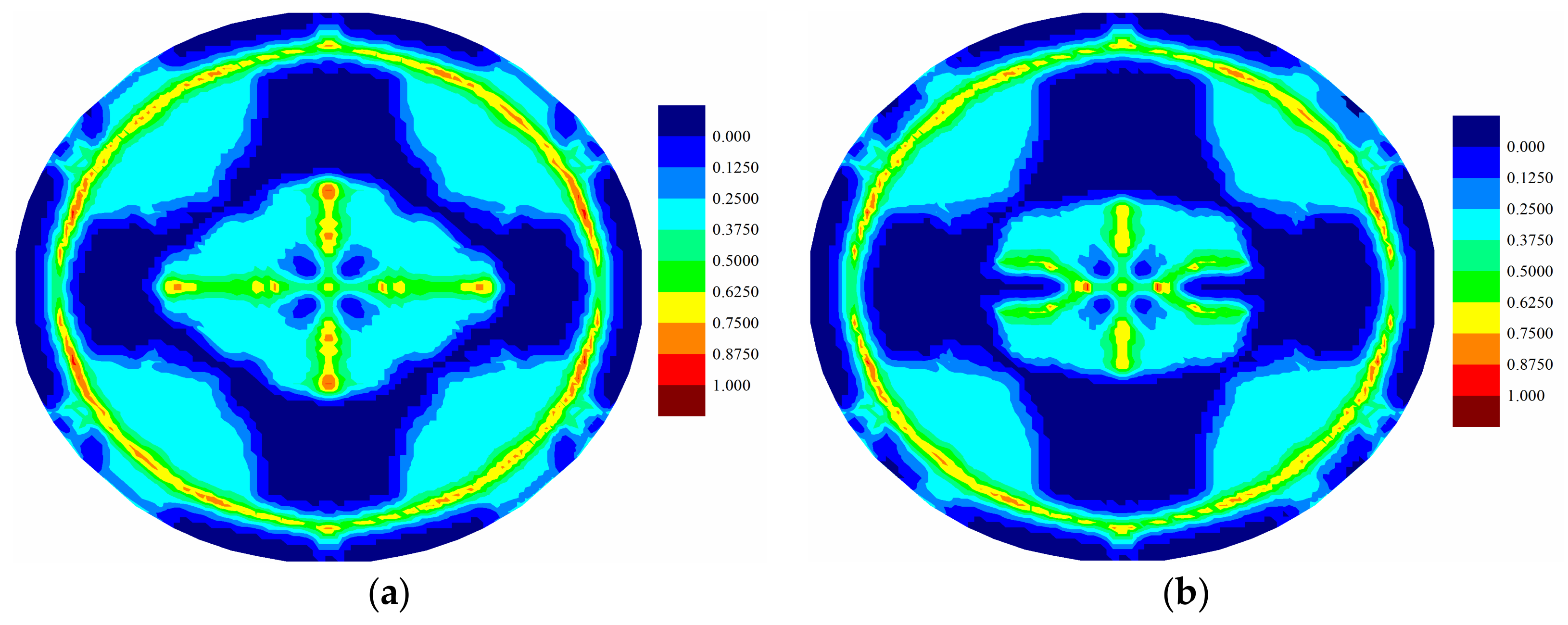
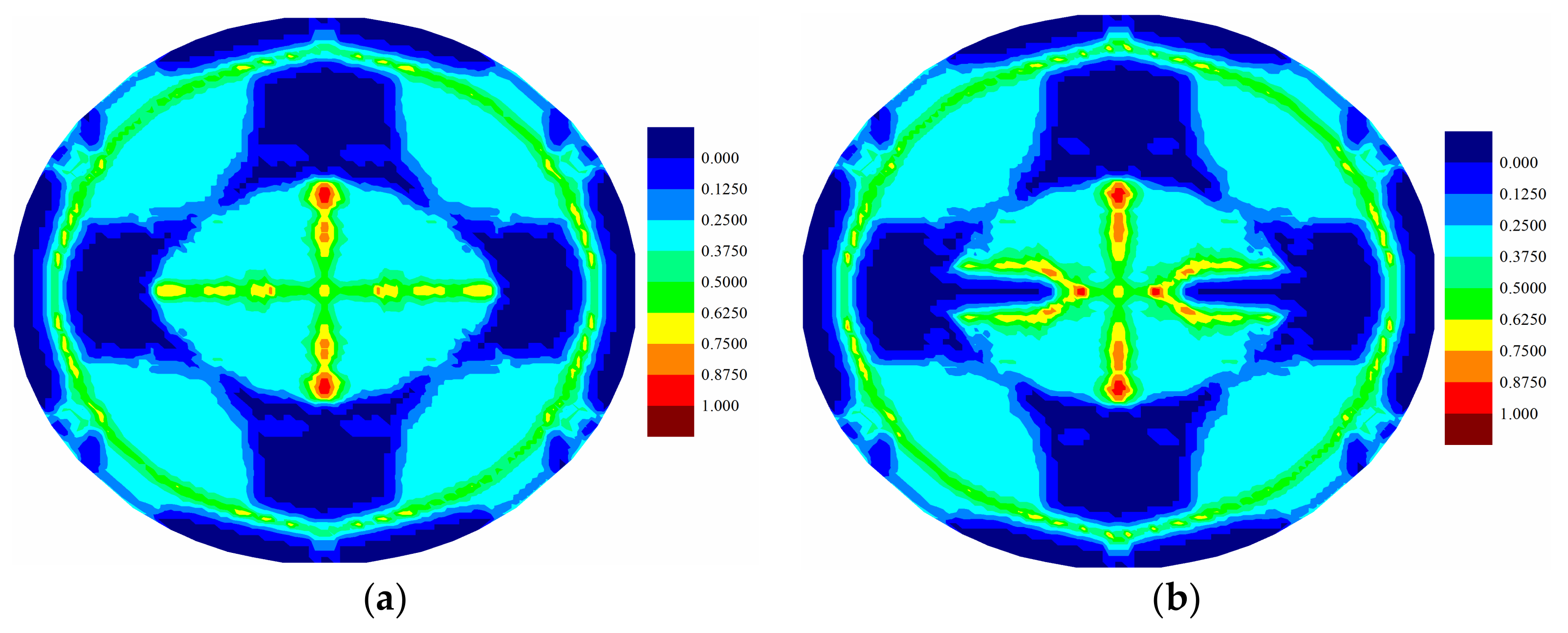
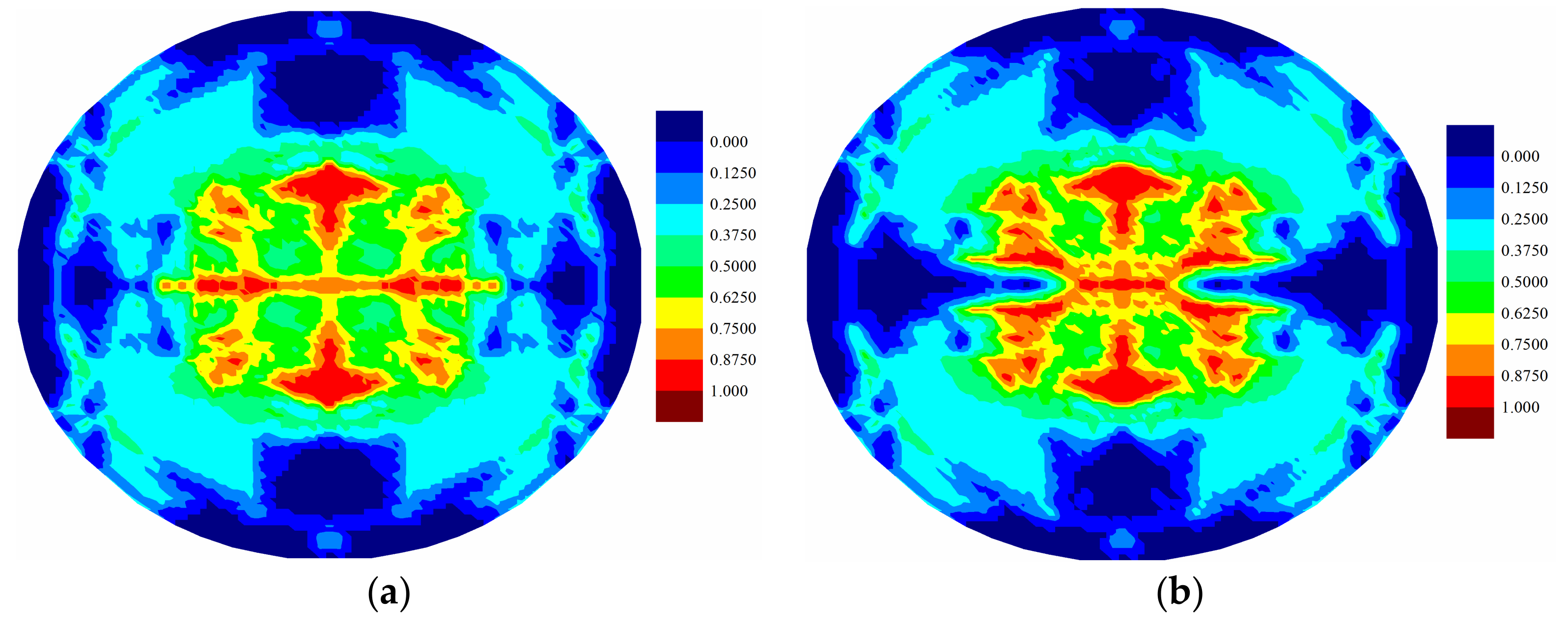
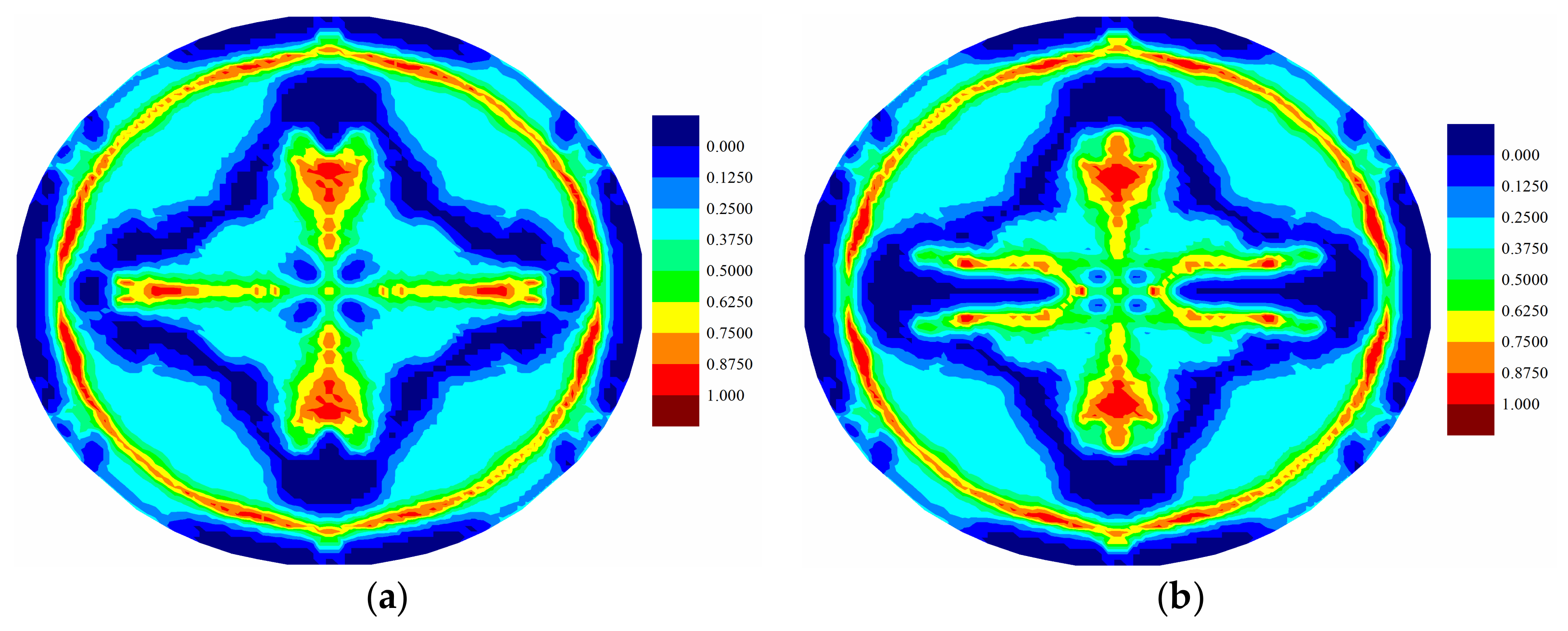
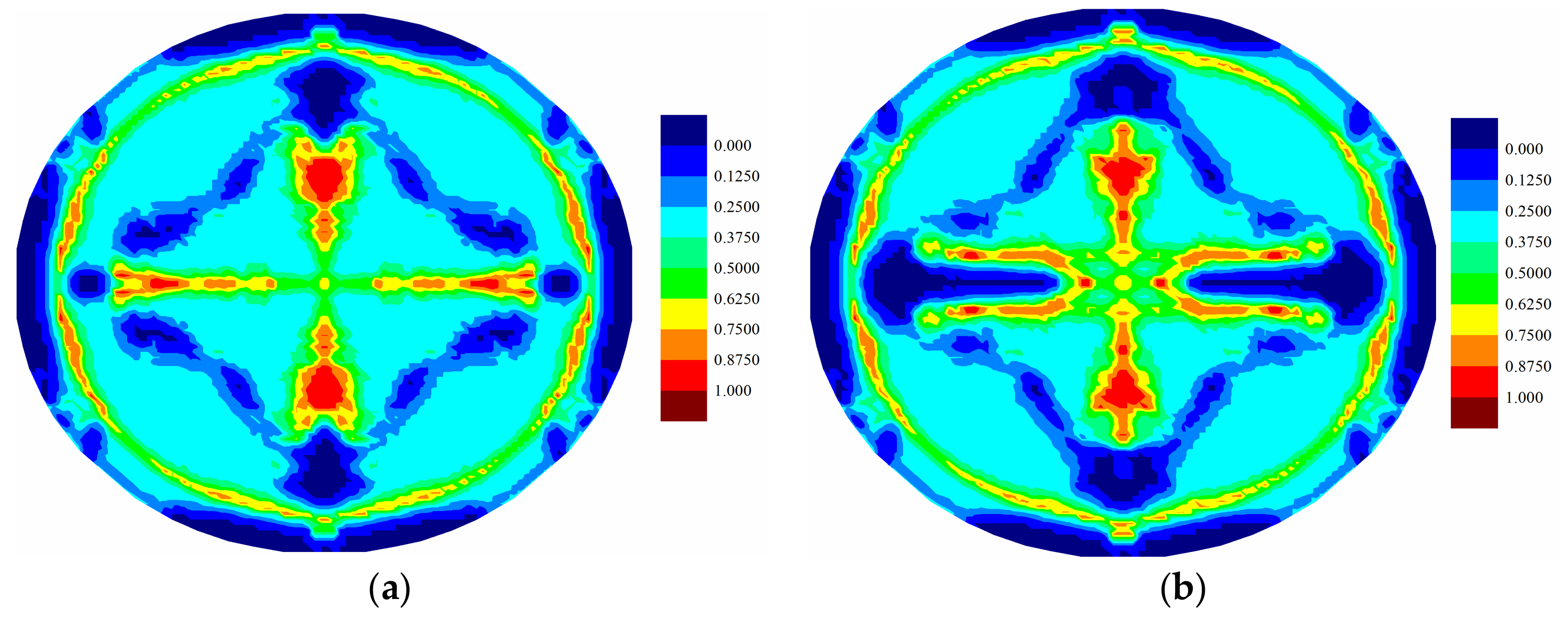

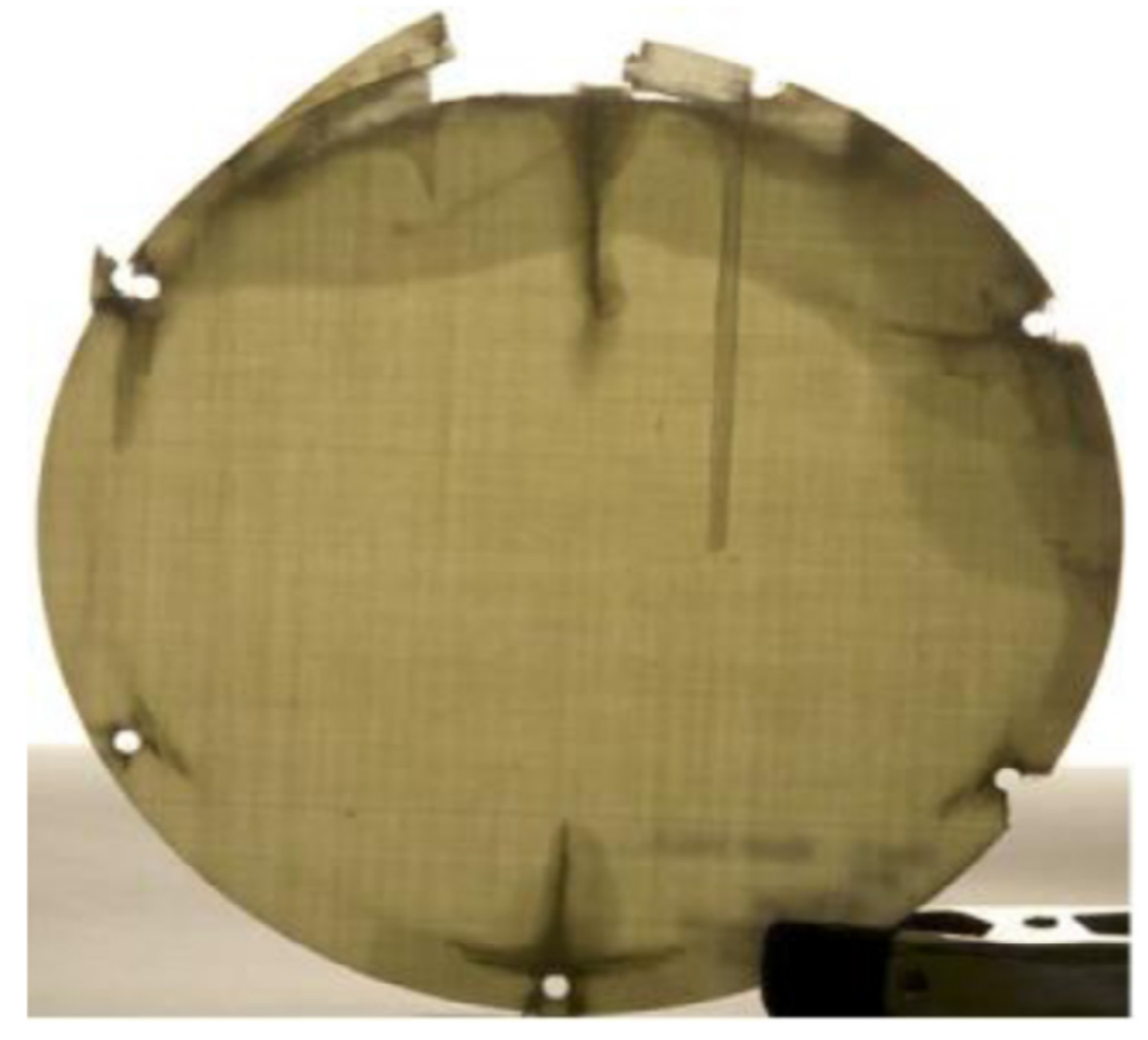
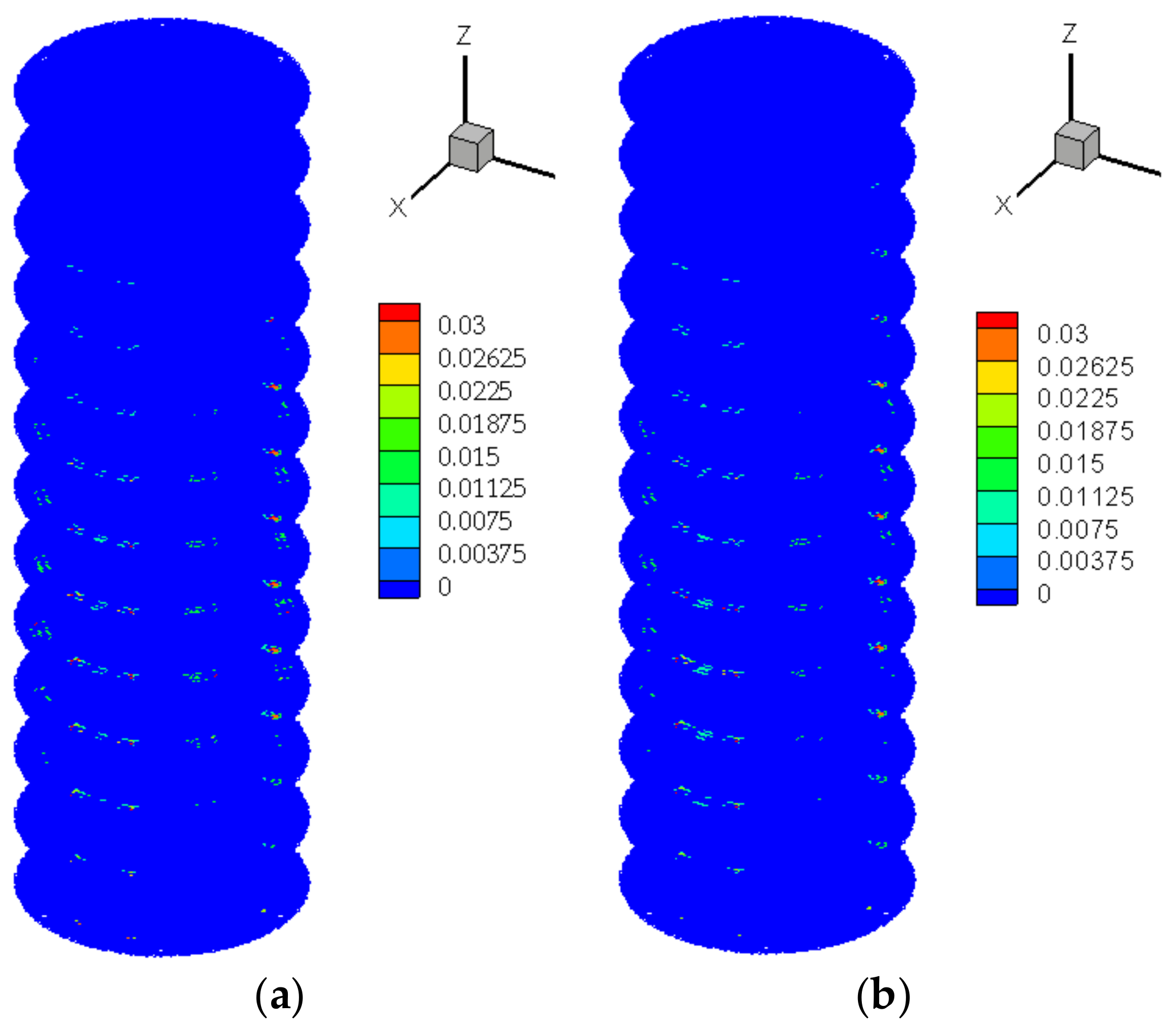
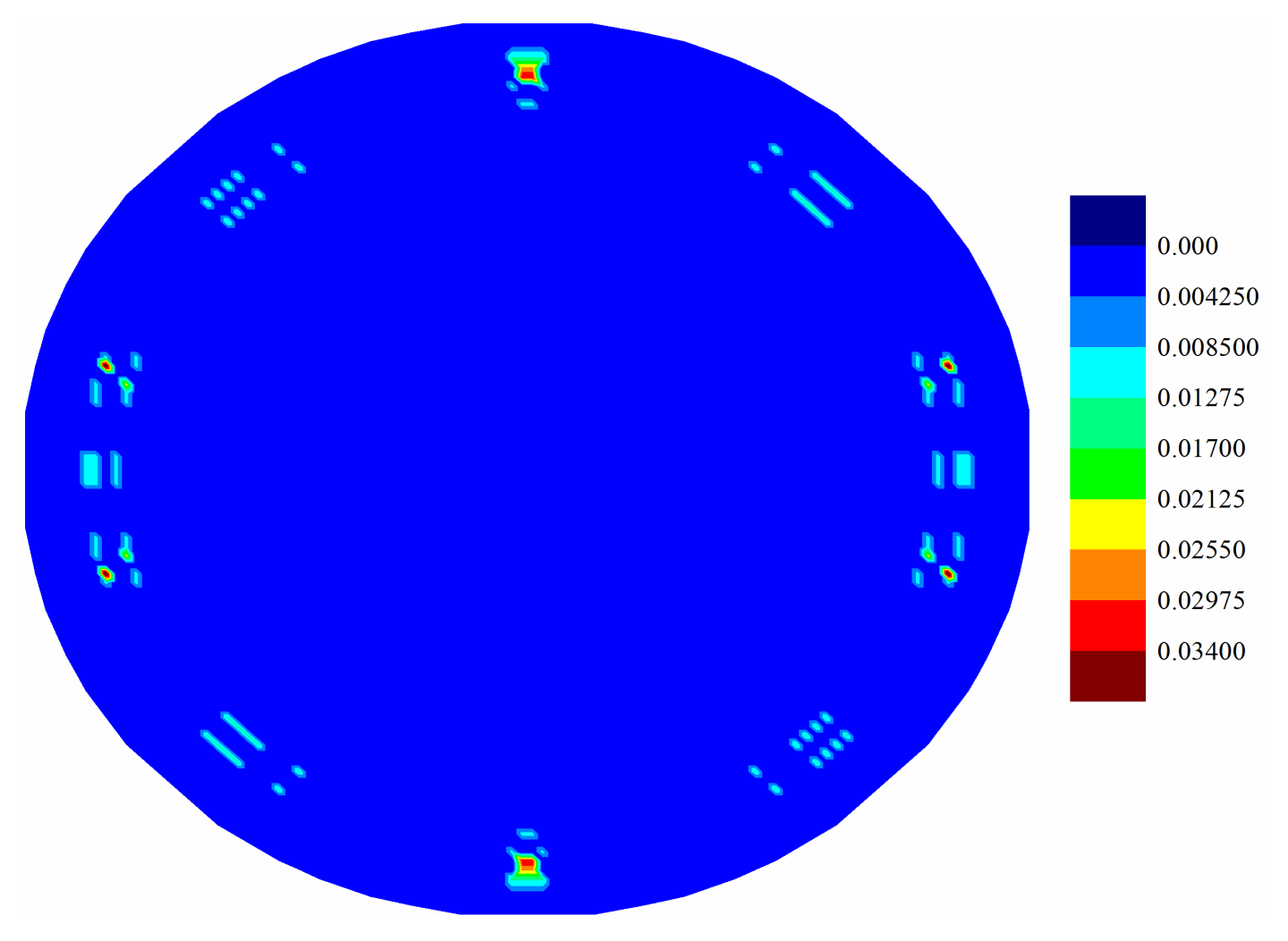
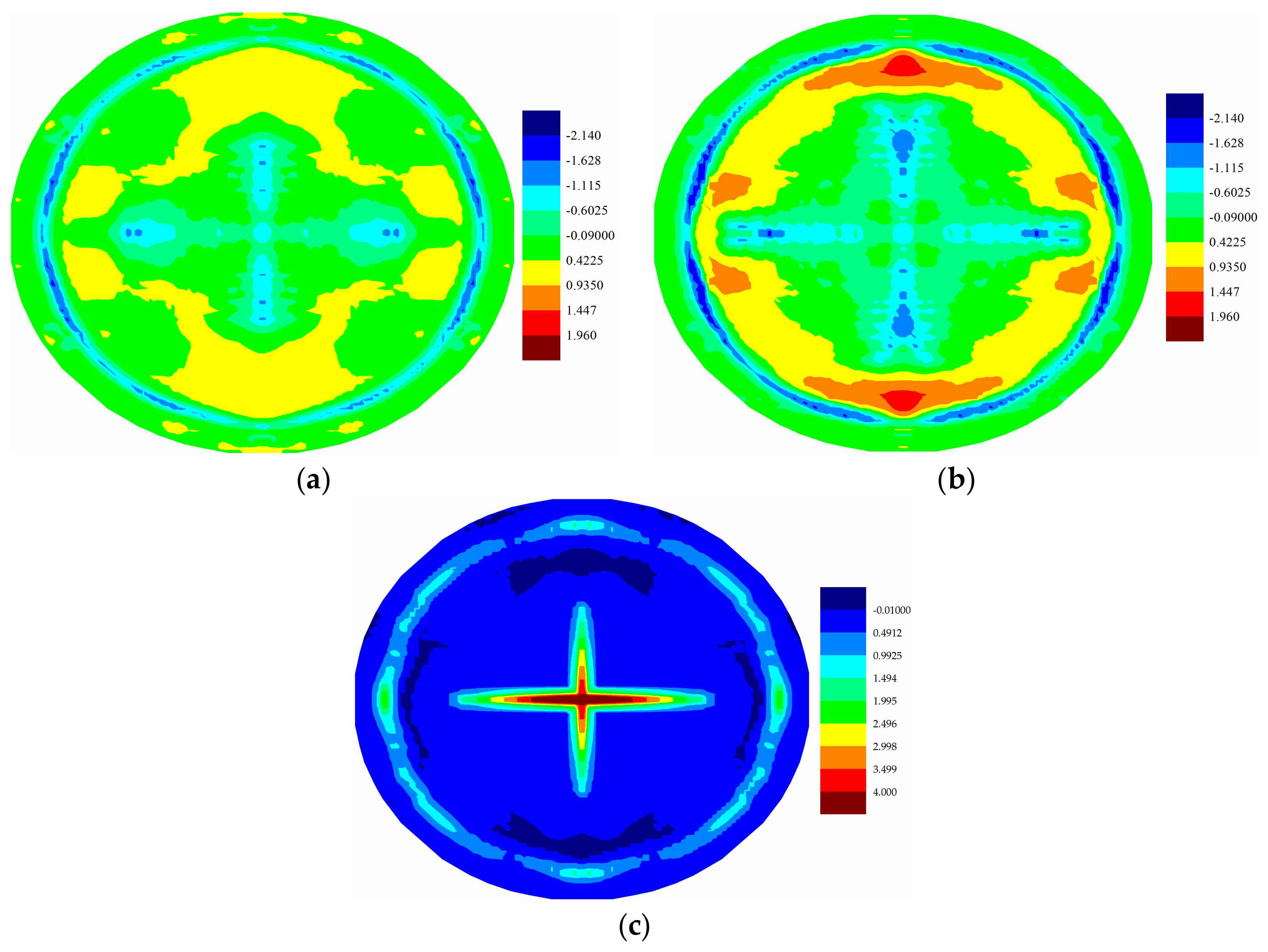
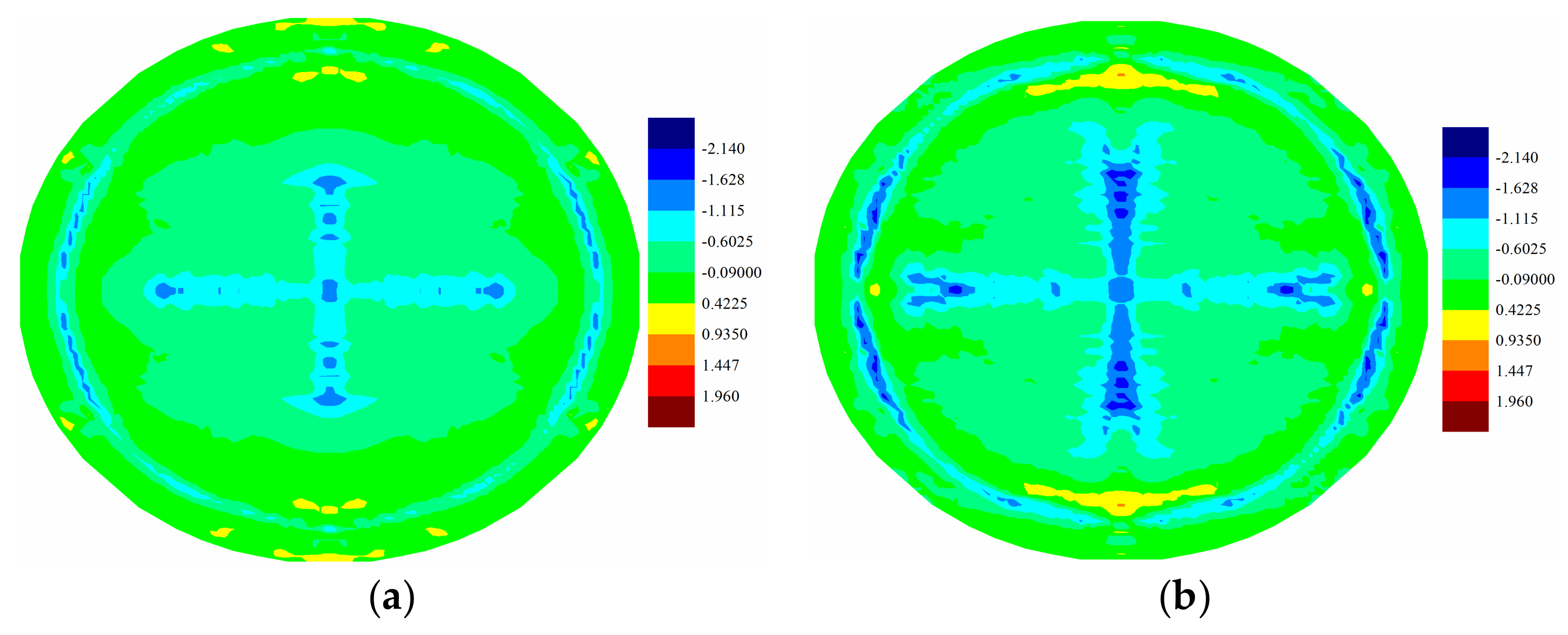
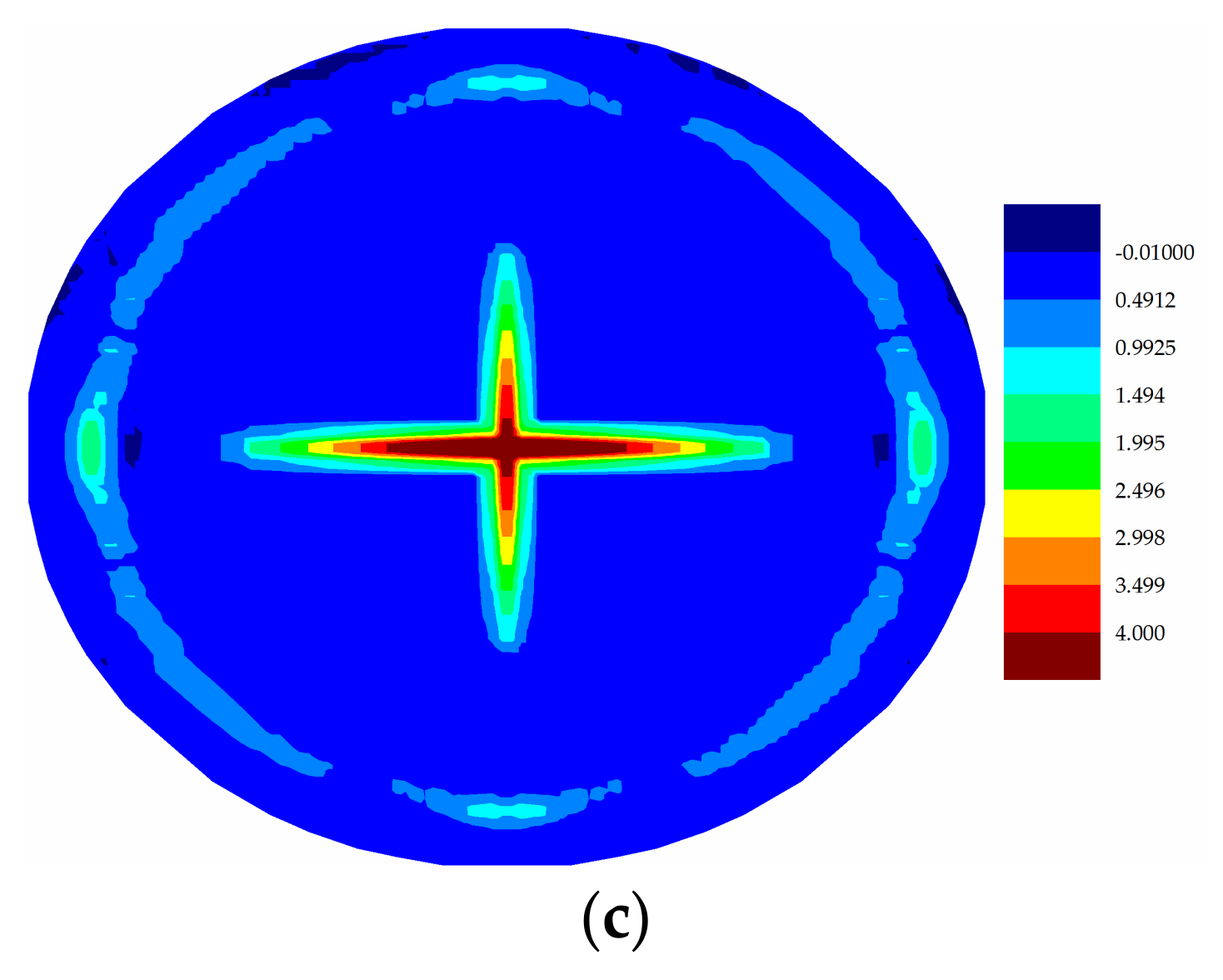
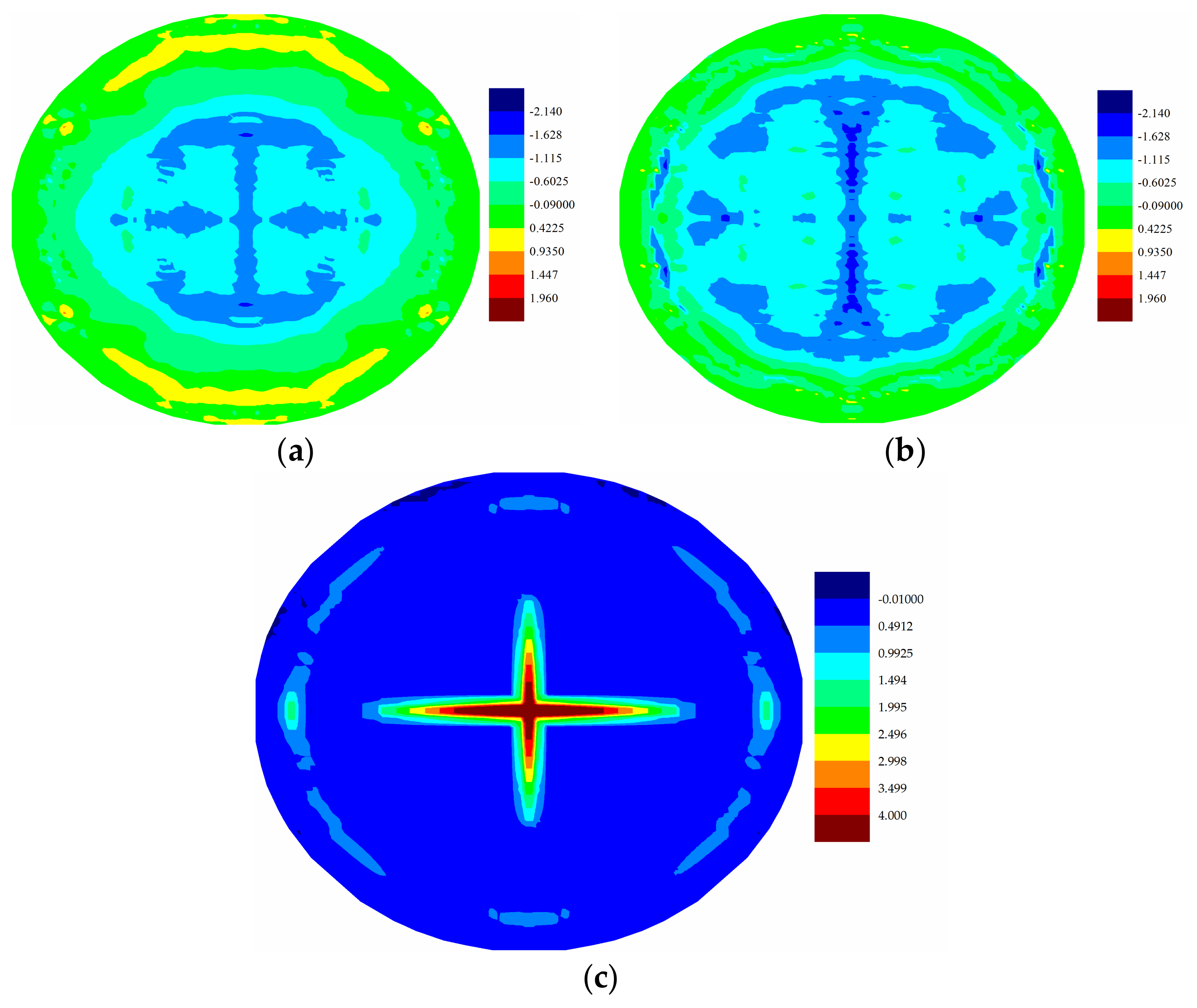
| Mechanical Properties | Thermal Properties | ||
|---|---|---|---|
| 39.3 | 8.6 | ||
| 9.7 | 22.1 | ||
| 3.32 | 10.4 | ||
| Poisson’s ratio | 0.33 | 0.89 | |
| 1850 | 879 | ||
| 3.792 | 63 | ||
| 1.422 | 0.34 | ||
| Poisson’s ratio | 0.33 | 285 | |
© 2018 by the authors. Licensee MDPI, Basel, Switzerland. This article is an open access article distributed under the terms and conditions of the Creative Commons Attribution (CC BY) license (http://creativecommons.org/licenses/by/4.0/).
Share and Cite
Gao, Y.; Oterkus, S. Peridynamic Analysis of Marine Composites under Shock Loads by Considering Thermomechanical Coupling Effects. J. Mar. Sci. Eng. 2018, 6, 38. https://doi.org/10.3390/jmse6020038
Gao Y, Oterkus S. Peridynamic Analysis of Marine Composites under Shock Loads by Considering Thermomechanical Coupling Effects. Journal of Marine Science and Engineering. 2018; 6(2):38. https://doi.org/10.3390/jmse6020038
Chicago/Turabian StyleGao, Yan, and Selda Oterkus. 2018. "Peridynamic Analysis of Marine Composites under Shock Loads by Considering Thermomechanical Coupling Effects" Journal of Marine Science and Engineering 6, no. 2: 38. https://doi.org/10.3390/jmse6020038





